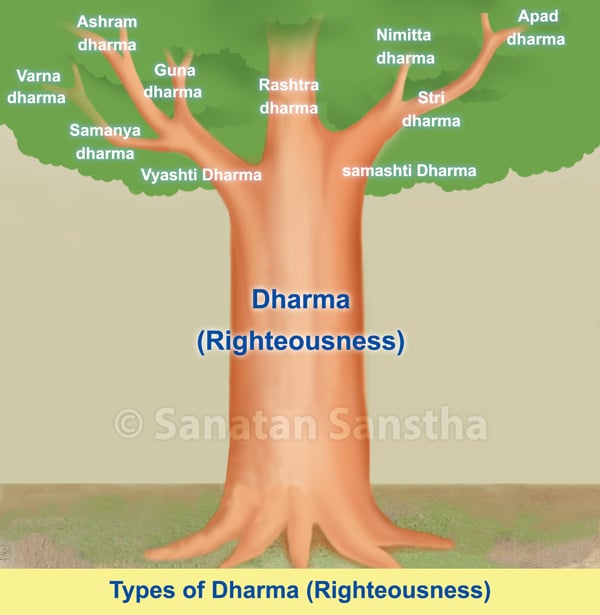
Life without Dharma is akin to life without oxygen, that in other words is being as good as dead. Dharma is the soul of an individual. Reaching a stage where the eternity of the soul is understood is itself reaching a stage of attaining Moksha (Final Liberation). This article elaborates on different types of Dharma in various contexts such as depending upon class one belongs to, stages of life, role being played, circumstances etc.
1. Samanyadharma
क्षमा सत्यं दमः शौचं दानमिन्द्रियसंयमः ।
अहिंसा गुरुशुश्रूषा तीर्थानुसरणं दया ।
आर्जवं लोभशून्यत्वं देवब्राह्मणपूजनम् ।
अनभ्यसूया च तथा धर्मः सामान्य उच्यते । – Vishnudharmasutra, Adhyaya 2, Sutra 16, 17
Meaning : Samanyadharma includes mercy, truth, control over the mind, purity, offerings, control over the senses, non-violence, service unto the Guru, pilgrimage, compassion, honesty, absence of greed, honouring Deities and Brahmans and not criticising anyone.
2. Varnadharma
Brahman, Kshatriya, Vaishya and Shudra are the four classes. Dharma applicable to the respective class is known Varnadharma.
3. Ashramdharma
Brahmacharyashram, Gruhasthashram, Vanaprasthashram and Sanyasashram are the four ashrams. This is limited to a particular stage of life
4. Gunadharma
This refers to the duty to be performed in accordance with the role one is playing or the position one is occupying, for example, the duty of a King is to nurture his subjects. The attributes of the five cosmic elements are also called gunadharma, for example, the gunadharma of water is coolness, liquidity, to flow from high to low area etc. These attributes are understood as science in modern language; however, in the Bharatiya culture, it is referred to as ‘swabhav’. Here ‘swa’ should be considered as God. The way God manifests from an object is the swabhav of that object
5. Nimittadharma
This is the variation in behaviour that one has to make according to the prevailing circumstances, for example, during Navaratra a lamp is lit uninterruptedly. If for some reason the lamp goes off, then it is lit again and as an atonement one has to chant the name of the Deity 108 times.
6. Apaddharma
This is expressed by the quote ‘आपदि कर्तव्यो धर्मः ।’ which means, the code of Dharma that should be followed during a calamity. In the system of the four classes, each class is assigned duties as per Dharma. Often due to unforeseen reasons such as Divine and earthly (spiritual or physical) crises, revolutions, famine, forcible migration etc., there is a sudden collapse in the system of classes, and it becomes impossible for people to perform karma prescribed according to their class. This hampers the means of their livelihood. Under such circumstances, according to an arrangement created by the Scriptures as an exception, an individual belonging to one class is allowed to accept the Dharma of the other classes. This arrangement is called Dharma in times of adversity. However, the Scriptures also preach that once the crisis is over or after social life is restored to normalcy, one should undertake penance and start practising one’s own Dharma all over again.
A. Types of adverse times
Adverse times are of 3 types.
-
Spiritual crisis : The crisis caused due to drought etc.
-
Physical crisis : The crisis caused by the enemies.
-
Crisis due to some mistake : Punishment received from the Guru for one’s fault / mistake is a crisis due to a mistake.
B. Importance of understanding the nature of Apaddharma !
Apaddharma is formed by a combination of Dharma and morality. It shows signs of Vedic Dharma and hence, is called as Apaddharma.
The concession granted during the adverse times is restricted only to the end of the adverse times and beginning of a favourable time. Yet, Apaddharma has become everlasting Dharma in today’s life. Hence, man is unable to progress spiritually. For this reason, continuing with Apaddharma in favourable times is adharma (Unrighteousness).
7. Stridharma (Dharma of a woman)
-
भर्तुः शुश्रूषया नारी लभते स्वर्गमुत्तम् ।
अपि या निर्नमस्कारा निवृत्ता देवपूजनात् ।। – Valmikiramayan, Ayodhyakanḍa, Sarg 24, Shloka 26
Meaning : (Shriram says to His mother Kausalya) The woman who does not pay obeisance to Deities or does not worship them, but serves only her husband acquires supreme heaven.
-
पतिर्हि देवो नारीणां पतिर्बन्धुः पतिर्गतिः ।
पत्या समा गतिर्नास्ति दैवतं वा यथा पतिः ।। – Mahabharat, Anushasanparva, Adhyaya 143, Shloka 55
Meaning : To a woman her husband is her God, companion and seat of refuge. A woman cannot progress spiritually without a husband. Truly, a husband is equivalent to God.
8. Vyashti (Individual) and samashti (Society) Dharma
Dharma is symptomatic in a dual way – active in worldly life and cessation of participation in worldly affairs. Here both vyashti and samashti conditions are given due consideration. This consideration in itself is the relativity. Non-violence can be the Dharma of vyashti since staying away from day-to-day activities is a major part of spiritual practice therein. But this is not the case with a Nation. In this case, it is all about activities for the sake of the society. In such a case, presence of Brahmatej (Radiance of knowledge) and Kshatratej are required. As a result, in these activities the non-violence that destroys the Truth is avoided, meaning, in that situation the violence itself becomes non-violence (Dharma). Punishing an unrighteous person does not amount to violence. The meaning of violence should not be taken as inflicting unhappiness; it should be taken as causing harm. When punishing an evildoer, the aim is not to make him unhappy; rather to alleviate the harm caused to him and also to allow him to attain a higher quality of happiness acquired by following Dharma.
9. Rashtradharma (also known as Samashti Dharma)
The spiritual practice of putting in efforts for the elevation of the Nation is Rashtradharma.
Reference : Sanatan Sanstha’s Holy text ‘Abiding by and protection of Dharma‘ and ‘Fundamental analysis of Dharma‘

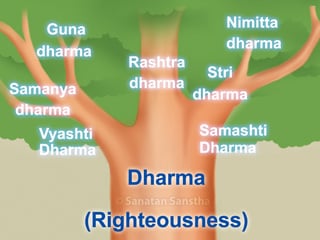
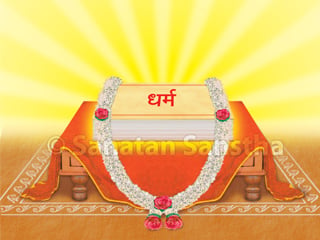 What is the true meaning of word Dharma (Righteousness) ?
What is the true meaning of word Dharma (Righteousness) ?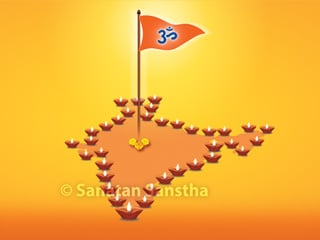 Dharma (Righteousness) and the importance of India (Bharat)
Dharma (Righteousness) and the importance of India (Bharat)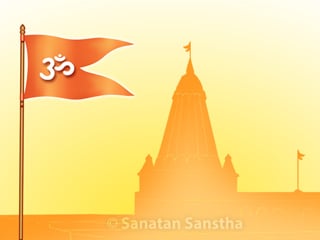 Hindu Dharma
Hindu Dharma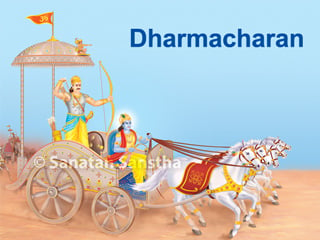 Why is it essential to adhere to Righteousness (Living Dharma) ?
Why is it essential to adhere to Righteousness (Living Dharma) ?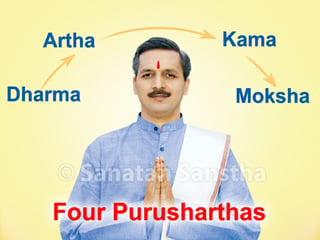 Dharmasiddhant - Principles of Hinduism (Doctrines of Dharma [Righteousness] )
Dharmasiddhant - Principles of Hinduism (Doctrines of Dharma [Righteousness] )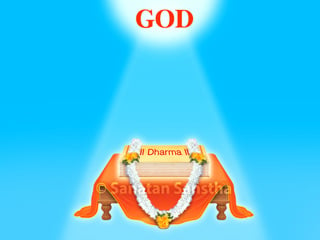 Decline of Dharma (Righteousness) and Incarnation of God
Decline of Dharma (Righteousness) and Incarnation of God